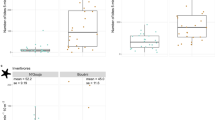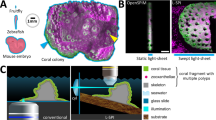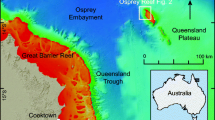Abstract
Deep-water corals are found along the oceanic margins world-wide and in the north east Atlantic the most abundant species is Lophelia pertusa (L.). There is now growing evidence that deep-water reefs formed by such species are coming under increasing pressures from resource exploitation, principally deep-sea trawling and hydrocarbon exploration. Here a novel and unobtrusive method of recording deep-water coral behaviour in the laboratory is described using time-lapse video to record silhouettes of the polyps under infrared illumination. The polyps of L. pertusa behaved asynchronously and did not show any clear diurnal patterns over a three-day observation period. Conceptually, sessile benthic suspension feeders appear to be vulnerable to smothering by sediments disturbed by bottom trawls or sub-seabed drilling. This method allows deep-water coral polyp behaviour to be continuously monitored in the laboratory and, therefore, the responses of coral polyps to environmental perturbations such as sedimentation can be recorded. Further work is necessary to resolve the sensitivity of deep-water corals to short-term environmental change and the combined approach of in situ monitoring and subsequent laboratory experimentation has great potential to address these issues.
Similar content being viewed by others
References
Batty, R. S., 1983. Observation of fish larvae in the dark with television and infrared illumination. Mar. Biol. 76: 105–107.
Benos, D. J. & R. D. Prusch, 1973. Osmoregulation in Hydra: column contraction as a function of external osmorality. Comp. Biochem. Physiol. 44A: 1397–1400.
Buchanan, J. Y., 1886. On oceanic shoals discovered in the s.s. ‘Dacia’ in October 1883. Proc. r. Soc. Edin. 13: 428–443.
Dons, C., 1944. Norges korallrev. Det Kongelige Norske Videnskabers Selskabs, Forhandlinger 16: 37–82.
Fosså, J. H., P. B. Mortensen & D. M. Furevik, 2002. The deepwater coral Lophelia pertusa in Norwegian waters: distribution and fishery impacts. Hydrobiologia 471: 1–12.
Frederiksen, R., A. Jensen & H. Westerberg, 1992. The distribution of the scleractinian coral Lophelia pertusa around the Faroe Islands and the relation to internal tidal mixing. Sarsia 77: 157–171.
Freiwald, A., J. B. Wilson & R. Henrich, 1999. Grounding Pleistocene icebergs shape recent deep-water coral reefs. Sedimentary Geol. 125: 1–8.
Jensen, A. & R. Frederiksen, 1992 The fauna associated with the bank-forming deepwater coral Lophelia pertusa Scleractinia on the Faroe shelf. Sarsia 77: 53–69.
Jones, J. B., 1992. Environmental impact of trawling on the seabed: a review. New Zealand J. mar. Freshwat. Res. 26: 59–67.
Koslow, J. A., G. W. Boehlert, J. D. M. Gordon, R. L. Haedrich, P. Lorance & N. Parin, 2000. Continental slope and deep-sea fisheries: implications for a fragile ecosystem. ICES J. mar. Sci. 57: 548–557.
Long, D., J. M. Roberts & E. J. Gillespie, 1999. Occurrences of Lophelia pertusa on the Atlantic margin. British Geological Survey Technical Report WB/99/24.
Mortensen, P. B., 2001. Aquarium observations on the deep-water coral Lophelia pertusa (L., 1758) (Scleractinia) and selected associated invertebrates. Ophelia 54: 83–104.
Mortensen, P. B., J. M. Roberts & R. C. Sundt, 2000. Videoassisted grabbing: a minimally destructive method of sampling azooxanthellate coral banks. J. mar. biol. Ass. U.K. 80: 365–366.
Mortensen, P. B., M. Hovland, T. Brattegard & R. Farestveit, 1995. Deep water bioherms of the scleractinian coral Lophelia pertusa L. at 64 N on the Norwegian shelf: structure and associated Megafauna. Sarsia 80: 145–158.
Robbins, R. E. & J. M. Shick, 1980. Expansion-contraction behaviour in the sea anemone Metridium senile: environmental cues and energetic consequences. In: Smith, D. C. & Y. Tiffan (eds), Nutrition in the Lower Metazoa. Oxford, Pergamon Press: 101–116.
Roberts J. M., S. M. Harvey, P. A. Lamont, J. D. Gage & J. D. Humphery, 2000. Seabed photography, environmental assessment and evidence for deep-water trawling on the continental margin west of the Hebrides. Hydrobiologia 441: 173–183.
Roberts, J. M., D. Long, J. B. Wilson, P. B. Mortensen & J. D. Cage, in prep. The deep-water coral Lophelia pertusa and enigmatic seabed mound structures along the northeast Atlantic margin: are they related?
Roberts, M., 1997. Coral in deep water. New Sci. 2100: 40–43.
Rogers, A. D., 1999. The biology of Lophelia pertusa Linnaeus 1758 and other deep-water reef-forming corals and impacts from human activities. Int. Rev. Hydrobiol. 844: 315–406.
Shashar, N., Y. Cohen & Y. Loya, 1993. Extreme diel fluctuations of oxygen in diffusive boundary layers surrounding stony corals. Biol. Bull. mar. Lab., Woods Hole 185: 455–461.
Shelton, G., 1980. Lophelia pertusa L.: electrical conduction and behaviour in a deep-water coral. J. mar. biol. Ass. U.K. 60: 517–528.
Shick, J. M., 1991. A Functional Biology of Sea Anemones. London, Chapman & Hall: 395 pp.
Teichert, C., 1958. Cold-and deep-water coral banks. Bull. amer. Ass. Petroleum Geol. 425: 1064–1082.
Wilson, J. B., 1979. ‘Patch’ development of the deep-water coral Lophelia pertusa L. on Rockall Bank. J. mar. biol. Ass. U.K. 59: 165–177.
Author information
Authors and Affiliations
Rights and permissions
About this article
Cite this article
Roberts, J., Anderson, R. A new laboratory method for monitoring deep-water coral polyp behaviour. Hydrobiologia 471, 143–148 (2002). https://doi.org/10.1023/A:1016513607002
Issue Date:
DOI: https://doi.org/10.1023/A:1016513607002




